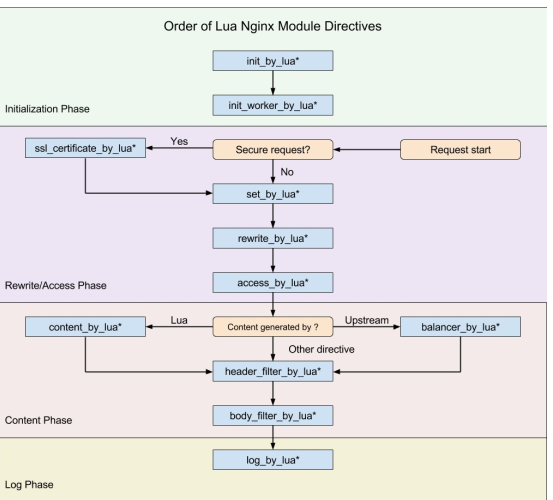这篇文章主要讲解OpenResty常见的api。
vim /usr/example/example.conf
location /lua_var {
default_type 'text/plain';
content_by_lua_block {
ngx.say(ngx.var.arg_a)
}
}
重新加载nginx配置文件: nginx -s reload
在浏览器上访问http://116.196.177.123/lua_var?a=323,浏览器显示:
323
在上述代码中,涉及到了2个api, 一是ngx.say(直接返回请求结果);二是ngx.var,它是获取请求的参数,比如本例子上的?a=323,获取之后,直接输出为请求结果。
获取请求类型
vim /usr/example/example.conf
location /lua_request{
default_type 'text/html';
lua_code_cache off;
content_by_lua_file /usr/example/lua/lua_request.lua;
}
vim /usr/example/lua/lua_request.lua ,添加一下代码:
local arg = ngx.req.get_uri_args()
for k,v in pairs(arg) do
ngx.say("[GET ] key:", k, " v:", v)
end
ngx.req.read_body() -- 解析 body 参数之前一定要先读取 body
local arg = ngx.req.get_post_args()
for k,v in pairs(arg) do
ngx.say("[POST] key:", k, " v:", v)
end
在上述例子中有以下的api:
- ngx.req.get_uri_args 获取在uri上的get类型参数,返回的是一个table类型的数据结构。
- ngx.req.read_body 读取body,这在解析body之前,一定要先读取body。
- ngx.req.get_post_args 获取form表单类型的参数,返回结果是一个table类型的数据。
使用curl模拟请求:
curl ‘http://116.196.177.123/lua_request?a=323&b=ss’ -d ‘c=12w&d=2se3’
返回的结果:
[GET ] key:b v:ss
[GET ] key:a v:323
[POST] key:d v:2se3
[POST] key:c v:12w
获取请求头
vim /usr/example/lua/lua_request.lua ,在原有的代码基础上,再添加一下代码:
local headers = ngx.req.get_headers()
ngx.say("headers begin", "<br/>")
ngx.say("Host : ", headers["Host"], "<br/>")
ngx.say("user-agent : ", headers["user-agent"], "<br/>")
ngx.say("user-agent : ", headers.user_agent, "<br/>")
for k,v in pairs(headers) do
if type(v) == "table" then
ngx.say(k, " : ", table.concat(v, ","), "<br/>")
else
ngx.say(k, " : ", v, "<br/>")
end
end
重新加载nginx -s reload
使用curl模拟请求:
curl ‘http://116.196.177.123/lua_request?a=323&b=ss’ -d ‘c=12w&d=2se3’
[GET ] key:b v:ss
[GET ] key:a v:323
[POST] key:d v:2se3
[POST] key:c v:12w
headers begin<br/>
Host : 116.196.77.157<br/>
user-agent : curl/7.53.0<br/>
user-agent : curl/7.53.0<br/>
host : 116.196.77.157<br/>
content-type : application/x-www-form-urlencoded<br/>
accept : */*<br/>
content-length : 12<br/>
user-agent : curl/7.53.0<br/>
获取http的其他方法
vim /usr/example/lua/lua_request.lua ,在原有的代码基础上,再添加一下代码:
ngx.say("ngx.req.http_version : ", ngx.req.http_version(), "<br/>")
--请求方法
ngx.say("ngx.req.get_method : ", ngx.req.get_method(), "<br/>")
--原始的请求头内容
ngx.say("ngx.req.raw_header : ", ngx.req.raw_header(), "<br/>")
--请求的body内容体
ngx.say("ngx.req.get_body_data() : ", ngx.req.get_body_data(), "<br/>")
ngx.say("<br/>")
重新加载nginx -s reload
使用curl模拟请求:
curl ‘http://116.196.177.123/lua_request?a=323&b=ss’ -d ‘c=12w&d=2se3’
//....
ngx.req.http_version : 1.1<br/>
ngx.req.get_method : POST<br/>
ngx.req.raw_header : POST /lua_request?a=323&b=ss HTTP/1.1
Host: 116.196.77.157
User-Agent: curl/7.53.0
Accept: */*
Content-Length: 12
输出响应
vim /usr/example/example.conf,添加一个location,代码如下:
location /lua_response{
default_type 'text/html';
lua_code_cache off;
content_by_lua_file /usr/example/lua/lua_response.lua ;
}
vim /usr/example/lua/lua_response.lua 添加一下代码:
ngx.header.a="1"
ngx.header.b={"a","b"}
ngx.say("hello","</br>")
ngx.print("sss")
return ngx.exit(200)
上述代码中有以下api:
- ngx.header 向响应头输出内容
- ngx.say 输出响应体
- ngx.print输出响应体
- ngx.exit 指定http状态码退出
使用curl模拟请求, curl ‘http://116.196.177.123/lua_response’ ,获取的响应体如下:
hello
sss
日志输出
在配置文件vim /usr/example/example.conf 加上以下代码:
location /lua_log{
default_type 'text/html';
lua_code_cache off;
content_by_lua_file /usr/example/lua/lua_log.lua;
}
vim /usr/example/lua/lua_log.lua ,加上以下代码:
local log="i'm log"
local num =10
ngx.log(ngx.ERR, "log",log)
ngx.log(ngx.INFO,"num:" ,num)
重新加载配置文件nginx -s reload
curl ‘http://116.196.177.123/lua_log’
打开nginx 的logs目录下的error.log 文件:
tail -fn 1000 /usr/servers/nginx/logs/error.log
可以看到在日志文件中已经输出了日志,这种日志主要用于记录和测试。
日志级别:
- ngx.STDERR – 标准输出
- ngx.EMERG – 紧急报错
- ngx.ALERT – 报警
- ngx.CRIT – 严重,系统故障,触发运维告警系统
- ngx.ERR – 错误,业务不可恢复性错误
- ngx.WARN – 告警,业务中可忽略错误
- ngx.NOTICE – 提醒,业务比较重要信息
- ngx.INFO – 信息,业务琐碎日志信息,包含不同情况判断等
- ngx.DEBUG – 调试
内部调用
vim /usr/example/example.conf 添加以下代码:
location /lua_sum{
# 只允许内部调用
internal;
# 这里做了一个求和运算只是一个例子,可以在这里完成一些数据库、
# 缓存服务器的操作,达到基础模块和业务逻辑分离目的
content_by_lua_block {
local args = ngx.req.get_uri_args()
ngx.say(tonumber(args.a) + tonumber(args.b))
}
}
internal 关键字,表示只允许内部调用。使用curl模拟请求,请求命令如下:
$ curl ‘http://116.196.177.123/lua_sum?a=1&b=2’
由于该loction是一个内部调用的,外部不能返回,最终返回的结果为404,如下:
<html>
<head><title>404 Not Found</title></head>
<body bgcolor="white">
<center><h1>404 Not Found</h1></center>
<hr><center>openresty/1.11.2.4</center>
</body>
</html>
vim /usr/example/example.conf 添加以下代码:
location = /lua_sum_test {
content_by_lua_block {
local res = ngx.location.capture("/lua_sum", {args={a=3, b=8}})
ngx.say("status:", res.status, " response:", res.body)
}
}
上述的代码通过ngx.location.capture去调用内部的location,并获得返回结果,最终将结果输出,采用curl模拟请求:
$ curl ‘http://116.196.177.123/lua_sum_test’
返回结果如下:
status:200 response:11
重定向
vim /usr
location /lua_redirect{
default_type 'text/html';
content_by_lua_file /usr/example/lua/lua_redirect.lua;
}
ngx.redirect("http://www.fangzhipeng.com", 302)
http://116.196.177.123/lua_redirect
共享内存
vim /usr/servers/nginx/cong/nginx.conf
在http模块加上以下:
lua_shared_dict shared_data 1m;
location /lua_shared_dict{
default_type 'text/html';
content_by_lua_file /usr/example/lua/lua_shared_dict.lua;
}
local shared_data = ngx.shared.shared_data
local i = shared_data:get("i")
if not i then
i = 1
shared_data:set("i",i)
end
i = shared_data:incr("i",1)
ngx.say("i:",i)
多次访问 http://116.196.177.123/lua_shared_dict,浏览器打印:
i:1
i:2
i:3
i:4
i:5
OpenResty执行阶段的概念
以下内容来自于《openresty 最佳实践》

如上图所示,openresty的执行阶段分为
这样我们就可以根据我们的需要,在不同的阶段直接完成大部分典型处理了。
- set_by_lua* : 流程分支处理判断变量初始化
- rewrite_by_lua* : 转发、重定向、缓存等功能(例如特定请求代理到外网)
- access_by_lua* : IP 准入、接口权限等情况集中处理(例如配合 iptable 完成简单防火墙)
- content_by_lua* : 内容生成
- header_filter_by_lua* : 响应头部过滤处理(例如添加头部信息)
- body_filter_by_lua* : 响应体过滤处理(例如完成应答内容统一成大写)
执行阶段概念:
- log_by_lua* : 会话完成后本地异步完成日志记录(日志可以记录在本地,还可以同步到其 他机器) 实际上我们只使用其中一个阶段
- content_by_lua* ,也可以完成所有的处理。但这样做,会让 我们的代码比较臃肿,越到后期越发难以维护。把我们的逻辑放在不同阶段,分工明确,代 码独立,后期发力可以有很多有意思的玩法。
本文为原创文章,转载请标明出处。
本文链接:http://blog.fangzhipeng.com/openresty/2018/01/01/openresty-best-practice-4-openresty-api.html
本文出自方志朋的博客
![]()
(转载本站文章请注明作者和出处 方志朋-forezp)